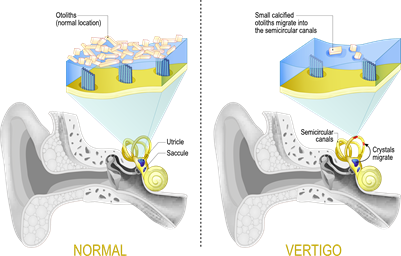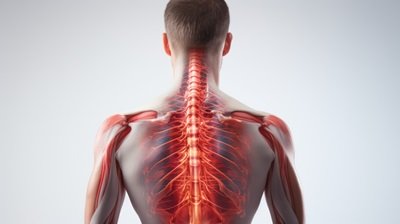Dizziness and vertigo are balance disorders that health professionals encounter regularly. Two conditions often confused due to overlapping symptoms are Benign Paroxysmal Positional Vertigo (BPPV) and Cervical Vertigo.
This blog will explain the differences between these common causes of vertigo and offer balance professionals valuable insights to enhance their diagnostic and therapeutic approaches.
What is Benign Paroxysmal Positional Vertigo (BPPV)?
BPPV is a prevalent vestibular disorder characterized by brief episodes of intense vertigo triggered by specific head movements.
In 1969, Schuknecht proposed a mechanism for BPPV, suggesting that particles, likely otolith organ otoconia or tiny crystals, stick to the cupula of the posterior semicircular canal, making it gravity -sensitive. Although this type of BPPV, known as cupulolithiasis, exists, it is rare.
The more widely accepted explanation for BPPV involves canaliths, free-floating particles within the semicircular canal. This type is called canalithiasis.

While BPPV is commonly associated with otoconia, the predominant type involves canaliths—particles that freely float within the semicircular canals.
BPPV Symptoms
Symptoms of BPPV include sudden onset vertigo, nausea, and nystagmus (involuntary eye movements). Patients often report these symptoms when changing positions, such as rolling over in bed or tilting their head back.
Traditional Diagnosis and Treatment for BPPV
Physical therapy and audiologists play a crucial role in diagnosing and treating BPPV. The Dix-Hallpike and Epley maneuvers are common methods to diagnose and treat BPPV.
During the Dix-Hallpike maneuver, the therapist quickly moves the patient from a sitting to a supine position with their head turned to one side, triggering vertigo if BPPV is present.
Once diagnosed, the Epley maneuver involves a series of head and body movements designed to reposition the displaced crystals within the inner ear, relieving symptoms. Balance professionals can guide patients through these maneuvers and educate them on home exercises to manage recurrent BPPV episodes.

Advancements in Diagnosing and Treating BPPV
While traditional BPPV diagnosis maneuvers are frequently used, recent innovations, including the TRV chair and Video Frenzel goggles (infrared video goggles), present distinct advantages over manual techniques.
The TRV Chair Advantages
The TRV Chair is designed to effectively diagnose and treat BPPV with distinct advantages. The TRV Chair:
- Prioritizes patient safety and comfort, accommodating those with neck or back issues, heavier patients, and frail individuals.
- Rotates 360-degrees to facilitate diagnosis and treatment of all BPPV types.
- The chair's versatility allows for advanced techniques like Dynamic maneuvers alongside traditional methods such as Epley or Semont maneuver, proving beneficial for addressing different BPPV types.
- The chair focuses on healthcare professionals' well-being by minimizing the risk of shoulder, neck, or back pain during patient maneuvering.

The TRV Chair facilitates the diagnosis and treatment of all types of BPPV.
Video Frenzel Goggles Advantages
Video Frenzel goggles can be used alone or alongside the TRV Chair to improve diagnosis and treatment.
- Video Frenzel goggles, like VisualEyes 505, allow you to record, measure and document a patient’s nystagmus.
- Quantifying a patient's nystagmus enables precise diagnosis and accurate tracking of improvement during intervention and therapy.
- Ensuring confidence in your diagnosis is crucial for recommending and optimizing treatment, facilitating swift patient improvement.
- Enhanced diagnostic capabilities contribute to elevated standards of patient care.

What is Cervical Vertigo?
Cervical Vertigo is a condition where dizziness is associated with neck movements or positions. Unlike BPPV, cervical vertigo is not rooted in the inner ear but originates from dysfunction in the cervical spine (neck). Common causes include cervical spondylosis, whiplash injuries, or cervical disc disorders.
Symptoms of Cervical Vertigo
Patients with cervical vertigo may experience dizziness, unsteadiness, and disorientation, often triggered by activities such as turning the head or maintaining a specific neck position for an extended period. It is crucial to distinguish cervical vertigo from other vestibular disorders, as treatment approaches differ significantly.
Cervical Vertigo Diagnosis
The diagnostic process for cervical vertigo involves a thorough examination of the patient's medical history, a comprehensive physical examination, and sometimes imaging studies such as X-rays or MRI to assess the cervical spine. Physical therapists can play a vital role in identifying cervical vertigo by evaluating the neck’s range of motion, muscle strength, and any signs of joint dysfunction.

Cervical vertigo arises from dysfunction in the cervical spine (neck).
Cervical Vertigo Treatment
Treatment strategies for cervical vertigo focus on addressing the underlying cervical spine issues. Physical therapists may incorporate manual therapy, exercises to improve neck mobility and strength, and postural training to alleviate symptoms. Patient education on proper ergonomics and neck care is also crucial for managing and preventing recurrent episodes of cervical vertigo.
BPPV and Cervical Vertigo
While BPPV and cervical vertigo share symptoms like dizziness and unsteadiness, distinct features help differentiate between the two conditions.
- BPPV is characterized by brief, intense episodes of vertigo triggered by specific head movements, often associated with changes in position.
- Cervical vertigo is more constant and linked to neck movements or sustained positions.
Understanding these disorders’ subtle yet critical differences is essential for accurate diagnosis and effective vestibular rehabilitation.
Do you want to learn more about diagnosing and treating balance disorders with advanced equipment? Our local experts are here to assist you.
Contact Us
Click to learn more about these innovations
TRV Chair
VisualEyes 505 Goggles
Other Good Reads: BPPV Treatment: The TRV Advantage
Follow us on Social!



If you haven't already, make sure to subscribe to our newsletter to keep up-to-date with our latest resources and product information.